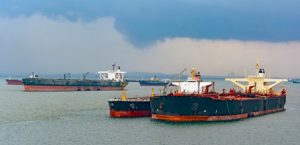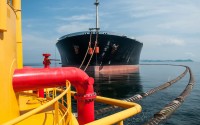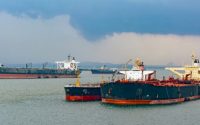Bunkering loading plan and checklist
Bunkering loading plan and checklist
The operation of ship’s bunkering changes constantly. It is vital to follow the rules in order that the operation is carried out in the safest way possible. There are so many points it is impossible to include them all. The Bunkering of fuel requires the utmost care to prevent any kind of accident or spill.

The first thing to do before any bunkering procedure is to identify the Person in Charge (P.I.C) of both sides of the transfers. I.E. The PIC for the Fuel supply side and the PIC for the receiving vessel. This individual must be a certified Master Mate Engineer or Tanker Man.
These people are in charge of the transfer at that time and must have full control over the vessels during the transfer.
The first task of the PIC is to identify the transfer procedures and share with the crew. The transfer procedures should be prominently displayed for the crew, for quick and easy reference. The oil transfer procedures should identify the location of pipelines, valves, vents and overflows.
It should include the numbers and duties of people assigned to the transfer operation and include all relevant procedures before, during and after the oil transfer.
It should also include detailed steps for communication among the bunkering team. Steps for topping off the tanks and steps for initiating an emergency shutdown.
The Pre-Loading Plan
This should include a description of the tanks and their capacities, the current oil level and type of oil, the expected final oil level, the sequence of filling and the monitoring procedures.
It should be stressed to the crew that monitoring is more than just watching what is happening, it is frequently watching the tank levels and valve alignments.
The PIC must stress to the bunker team that if anything appears to be out of order crew members have a responsibility to shut down the bunkering operation. When in doubt shut it down.
Designating Transfer personnel is a key responsibility, but regulations vary around the world, but it is highly advised that at least four individuals should devote their full time during the bunkering process.
In case of an emergency both sides of the bunkering teams should have a clear idea of how a problem should be communicated toi the other side. Radio frequencies should be checked, but backup signals such as hand signals should also be in place should radio communication fail.
When in doubt shut it down
One of the first thing you need to be aware of is the amount of sulphur used in the fuel. The safe amount since January 2012 is now 3.50% (it was previously 4.50%). It is vital that you do not commence bunkering until you know the sulphur levels are correct.
Although the plans below do not cover all eventualities, they give some idea of how to conduct safe bunkering.
You first need to make sure there is adequate space for bunkering. The deep tanks require 90% or under for bunkering, the double bottom tanks 85% or under and the final loading tank 80% or under. The order of the tank loading needs to be arranged so that there is not too much heel and trim during loading.
Concerning the personnel, the positioning and the demarcation of the work needs to be clarified and a list of people completing the task needs to be put up near the bunker station. The Master’s signature should then be obtained.
The transfer work procedures and a diagram of the piping should also be put up near the bunker station. Finally, for the plan there needs to be a meeting onboard of the personnel required and any points that require specific attention.
Different ports require different procedures to take place. In Washington state, USA the PIC needs to conduct a training session 48 hours before the bunkering takes place. It also needs to be recorded in the deck log book. The training needs to consist on the pre-loading, civil and criminal penalties and liabilities for incorrect behaviour, how the vessel’s oil should be transferred as well as English hand signals for communication and the shutdown procedures for any emergencies.
Before bunkering you need to make sure that any pipes and valves are clearing marked and the marking is correct. You need to see that the deck scuppers are plugged to an effective degree; this would mean cementing them up if they are wooden plugs. It needs to be confirmed that all pipes are fit for use – no cracks, corrosion or similar. To make further sure a leak test must be carried out. Next the valves and level gauges themselves should be tested, are the gauges completely accurate? Are all alarms for the valves working correctly, if fitted?
The bunker requisition form needs to have all the required information of the oil? That is, the specific gravity, the sulphur content, viscosity, grade and quality. You need to notify the watch keeping members of personnel that bunkering has started. Again, you need to be wary of any leaks and listen to the pipe for the flow of the oil. You also need to check that the oil is flowing into the correct tank. Other things to be aware of is any change in level with the other tanks and whether the flow is the correct speed. The time of starting also needs to be recorded.
Whenever valves are changed over the remote-control board should highlight this but you need on the spot confirmation wherever possible. You require that the oil flow in the correct tanks to be confirmed, as well as air blow from the air pipes. If there is no change in levels in the other tanks everything would seem to be correct.
The oil quality, the type of oil and its viscosity and density need to have been discussed with the oil supplier. The presence of H2S and the temperature of the oil need to be closely monitored. The rate of pumping needs to be worked out-usually it is slow to begin with. The local rules of oil leaks need to be discussed and adhered to.
If you have followed these procedures you should be ready to begin bunkering but you should always take into account any warning signs that difficulties in the process may occur at any time.
Bunkering Best Practices Training Video
This video was made with the generous support of the Pacific States/British Columbia Oil Spill Task Force (OSTF)


